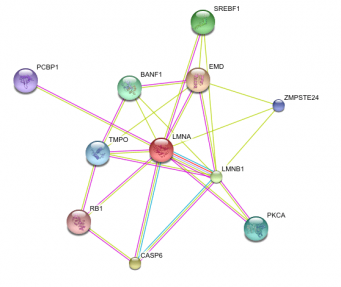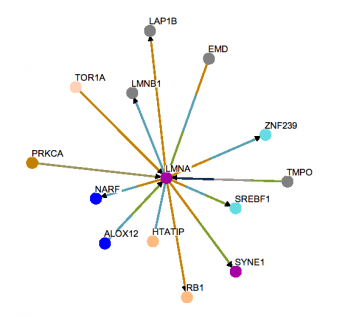This web page was created as an assignment for Genetics 677, an undergraduate course at UW-Madison.
Protein Interactions
STRING

STRING is a database of known and predicted protein interactions curated from high throughput experiments, coexpression experiments, genomic context, and known previous research from published journals. Information from different organisms are integrated into the database to establish a wide-variety of interactions, which include physical and functional interactions. Searches can be conducted for protein name or sequence, or multiple names and sequences. Also searches can be organism specific. Results contain predicted interactions, known interactions, literature of experimental evidence, and interactive diagrams.
Osprey

Osprey is a free downloadable software used for the visualization of protein interaction within an organism. Interactions are built through experimental interaction evidence and predicted interactions through gene function. Osprey allows the user to manipulate interaction networks and also build their own. Osprey is very flexible and gives the user a lot of freedom to investigate interactions and adjust the schematics to fit their objectives.
Analysis
The most important interaction with LMNA seen in these visuals is ZMPSTE24. This protein is involved in the post-translational processing of LMNA precursors. ZMPSTE24-null mice show progeroid symptoms of HGPS patients on both cellular and outward appearance. (1) Knowing that models deficient in this protein show accelerated aging features and that it directly interacts with LMNA open up a new avenue for research into progeroid diseases, like HGPS. A second protein, CASP6, is important to the cell cycle process, specifically the proper cleavage of lamin A into its mature product. With defects in capase-6, apoptotic cycles do not function correctly. (2) It becomes very apparent by looking at the interactions with LMNA, that this gene is absolutely essential in many cell cycle processes and any disruptions cause very harmful phenotypes.
References
Images taken from: STRING and Osprey.
1) GenAge entry for ZMPSTE24.
2) Ruchaud, S., Korfall, N., Villa, P., Kottke, T., Dingwall, C., Kaufmann, F., Earnshaw,, W. (2002). Caspase-6 gene disruption reveals a requirement for lamin A in apoptotic chromatin decondensation. The EMPBO Journal (21). Retrieved from: The EMBO Journal.
Peter St. Andre [email protected] Last updated:2/3/09
gen677.weebly.com
